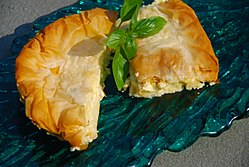Tiropita or tyropita (Greek: τυρóπιτα, "cheese-pie") is a Greek pastry made with layers of buttered phyllo and filled with a cheese-egg mixture.[1] It is served either in an individual-size free-form wrapped shape, or as a larger pie that is portioned.
 Tiropita with garnish. | |
| Place of origin | |
|---|---|
| Main ingredients | phyllo, eggs, cheese |
When made with kasseri cheese, it may be called kasseropita (κασερόπιτα).[2]
Spanakotiropita is filled with spinach and cheese; cf. spanakopita.[3]
History
According to some scholars, it is stated that in Ancient Greek cuisine, placenta cake (or plakous, πλακοῦς), and its descendants in Byzantine cuisine, plakountas tetyromenous (πλακούντας τετυρομένους, "cheesy placenta") and en tyritas plakountas (εν τυρίτας πλακούντας, "cheese-inserted placenta"), are the ancestors of modern tiropita.[4][5] A recipe in Greek tradition recorded in Cato the Elder's De Agri Cultura (160 BC) describes placenta as a sweet layered cheese dish:[4][6][7]
Shape the placenta as follows: place a single row of tracta along the whole length of the base dough. This is then covered with the mixture [cheese and honey] from the mortar. Place another row of tracta on top and go on doing so until all the cheese and honey have been used up. Finish with a layer of tracta...place the placenta in the oven and put a preheated lid on top of it [...] When ready, honey is poured over the placenta.
Placenta remains the name for a flat baked pie containing cheese in Aromanian (plãtsintã) and in Romanian (plăcintă).
Other sources state that Turks also developed similar layered dishes like tiropita. Layered pan-fried breads were developed by the Turks of Central Asia in the Late Middle Ages.[8]
The ancient tyropatinum described by Apicius, despite the similarity in name, was a sweet custard with no crust.[9]
See also

References
Citations
Sources
- Faas, Patrick (2005). Around the Roman Table: Food and Feasting in Ancient Rome. Chicago, IL: University of Chicago Press. ISBN 0226233472.
- Goldstein, Darra, ed. (2015). The Oxford Companion to Sugar and Sweets. Oxford: Oxford University Press. ISBN 978-0199313396.
- Musco, Tom (2003). UMass Journalism Sicily: A History of Sicilian Cuisine. Amherst, MA: University of Massachusetts Journalism Program.
- Perry, Charles (2000). "6. The Taste for Layered Bread among the Nomadic Turks and the Central Asian Origins of Baklava". In Zubaida, Sami; Tapper, Richard; Roden, Claudia (eds.). A Taste of Thyme: Culinary Cultures of the Middle East. London and New York: Tauris Parke Paperbacks. pp. 87–92. ISBN 1860646034.
- Salaman, Rena (1986). "The Case of the Missing Fish, or Dolmathon Prolegomena (1984)". In Davidson, Alan (ed.). Oxford Symposium on Food & Cookery 1984 & 1985, Cookery: Science, Lore and Books Proceedings. London: Prospect Books Limited. pp. 184–187. ISBN 9780907325161.
- Vryonis, Speros (1971). The Decline of Medieval Hellenism in Asia Minor and the Process of Islamization from the Eleventh through the Fifteenth Century. Berkeley, CA: University of California Press. ISBN 978-0-52-001597-5.